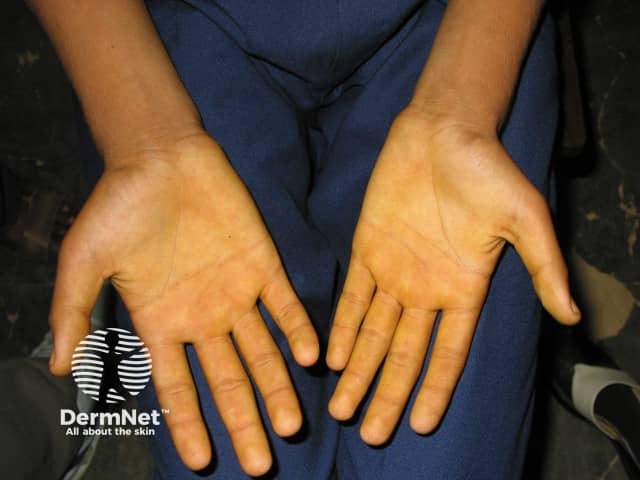Main menu
Common skin conditions

NEWS
Join DermNet PRO
Read more
Quick links
The differences in human skin and hair colour are among the most noticeable features of human variability. An individual’s skin and hair colour provides a clue to their ancestry and heritage. Skin and hair colour is primarily determined by the genes we inherit from our parents. But what is it that makes black skin and red hair?
Skin colour or pigmentation is determined by three pigments or chromophores:

Heavily melanised naevus

Red patch of psoriasis

Carotenoderma
Melanin content of skin is the main determining factor of skin and hair colour; hair is considered a form of skin with regards to pigmentation. Melanin is synthesized by melanosomes found in skin cells called melanocytes.
Whether you have dark skin or light skin depends on the amount and type of melanin produced in your skin. There are two types of melanin and the relative amounts of each determine your skin and hair colouring.
Eumelanin:phaeomelanin ratio |
Skin colour |
Hair colour |
|---|---|---|
High eumelanin and low phaeomelanin |
Black or dark skin |
Brown or black |
High phaeomelanin and low eumelanin |
Light skin and freckles |
Red (very high phaeomelanin) or yellow |
None or very little eumelanin or pheomelanin (albinism) |
Pale |
White |
The table above gives a very simplistic explanation for skin and hair colour determination. Many other factors are involved, including a gene protein called melanocortin 1 receptor (MC1R).
Increased activity of MC1R leads to the production of more eumelanin and less phaeomelanin, resulting in darkening of skin and hair. People who have impaired MC1R genes tend to have red hair and fair skin with freckles. This gene mutation increases the risk of skin cancer, particularly melanoma.
Changes in gene activity associated with skin and hair colouring has been occurring since the evolution of mankind. Migration and movement of humans over the continents meant skin colour evolved quickly and readily as an adaptation to new environments.
Not only do we see differences in the skin and hair colour between people but sometimes we see differences in the colour between different parts of our own body. Hair colour may vary both in time and site. For example, scalp hair may be blonde in a child, then darken to brown in adolescence, and eventually become white in old age. And why in an individual can scalp hair be black or dark brown whilst facial or pubic hair be red? A number of factors are at work to explain this diversity.
Skin exposure to sunlight (ultraviolet radiation) increases the production of melanin and can result in darker coloured skin (tanning). Repeated exposure to UVR can lead to darker skin and hair colour over time. Sun exposure can also cause brown spots and freckles, especially in fair-skinned individuals.
Pigmentation disorders can result in generalised or localised hyperpigmentation (increased skin colour) and hypopigmentation (reduced skin colour). Increase in melanin (hyperpigmentation or hypermelanosis) can be due to an increased number of pigment cells (melanocytes) or from increased production of melanin. Whilst a reduction in melanin results in pale patches (hypopigmentation or hypomelanosis) and total loss of melanin in white patches (leucoderma).
The number of melanocytes and the amount and type of melanin produced may be affected by body site, age and sex in the following ways:
One concern of many people is greying hair. Turning grey is partly due to an inherited trait and to aging.
The genetic factors responsible for pigmentary variations needs further investigation. A better understanding of MC1R and other genes will go a long way to help in explaining the variation in skin and hair color in human populations.